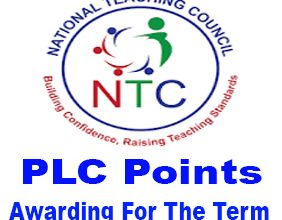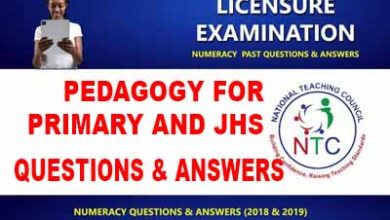NTC Licensure Exams Pedagogy For Primary And JHS Past Questions And Answers 6
GTLE Content Areas Exams Pedagogy For Primary And JHS
JOIN WHATSAPP HERE
NTC Licensure Exams Pedagogy For Primary And JHS Past Questions And Answers 1
NTC Licensure Exams Pedagogy For Primary And JHS Past Questions And Answers 2
NTC Licensure Exams Pedagogy For Primary And JHS Past Questions And Answers 3
NTC Licensure Exams Pedagogy For Primary And JHS Past Questions And Answers 4
NTC Licensure Exams Pedagogy For Primary And JHS Past Questions And Answers 5
NTC Licensure Exams Pedagogy For Primary And JHS Past Questions And Answers 6
NTC Licensure Exams JHS Integrated Science Past Questions And Answers
NTC Professional General Knowledge Past Questions and Answers (Literacy) 2024
NTC Professional General Knowledge Past Questions and Answers (Comprehension 1) 2024
NTC Professional General Knowledge Past Questions and Answers (Literacy) 2024
NTC Professional General Knowledge Past Questions and Answers (Comprehension) 2024
1. What is the best way to prevent misbehavior in the classroom?
A. Punishing students who misbehave
B. Ignoring misbehaviour in the hope that it will stop
C. Establishing clear expectations for behaviour
D. Yelling at students who misbehave to get them to stop
The correct answer is Establishing clear expectations for behaviour
2. What is the best way to prevent misbehavior in the classroom?
A. Punishing students who misbehave
B. Ignoring misbehavior in the hope that it will stop
C. Establishing clear expectations for behavior
D. Yelling at students who misbehave to get them to stop
Answer: C. Establishing clear expectations for behavior
3. Why is it important to establish clear expectations for behavior in the classroom?
A. To react impulsively to misbehavior
B. To ignore student actions and outbursts
C. To promote a positive and structured learning environment
D. To escalate conflicts and disagreements
Answer: C. To promote a positive and structured learning environment
4. How can clear expectations for behavior help prevent misbehavior?
A. By allowing students to misbehave without consequences
B. By reinforcing a positive classroom culture and mutual respect
C. By punishing students without warning
D. By encouraging a chaotic and disorganized classroom environment
Answer: B. By reinforcing a positive classroom culture and mutual respect
JOIN WHATSAPP HERE
NTC Licensure Exams Pedagogy For Primary And JHS Past Questions And Answers 1
NTC Licensure Exams Pedagogy For Primary And JHS Past Questions And Answers 2
NTC Licensure Exams Pedagogy For Primary And JHS Past Questions And Answers 3
NTC Licensure Exams Pedagogy For Primary And JHS Past Questions And Answers 4
NTC Licensure Exams Pedagogy For Primary And JHS Past Questions And Answers 5
NTC Licensure Exams Pedagogy For Primary And JHS Past Questions And Answers 6
NTC Licensure Exams JHS Integrated Science Past Questions And Answers
NTC Professional General Knowledge Past Questions and Answers (Literacy) 2024
NTC Professional General Knowledge Past Questions and Answers (Comprehension 1) 2024
NTC Professional General Knowledge Past Questions and Answers (Literacy) 2024
NTC Professional General Knowledge Past Questions and Answers (Comprehension) 2024
5. What impact can establishing clear expectations for behavior have on the overall classroom atmosphere?
A. By fostering a negative and unstructured learning environment
B. By reinforcing positive behavior and minimizing disruptions
C. By promoting conflicts and challenges among students
D. By ignoring the need for structure and expectations
Answer: B. By reinforcing positive behavior and minimizing disruptions
6. In what way can establishing clear behavior expectations contribute to effective classroom management?
A. By using punitive measures as the primary means of control
B. By encouraging students to misbehave without consequences
C. By creating a positive and structured learning environment
D. By escalating conflicts and discipline issues
Answer: C. By creating a positive and structured learning environment
7. One of the following options must be done by teachers in order to foster a positive atmosphere and avoid issues in the classroom.
A. Take individual differences into account, maintain students’ motivation, and reinforce positive behaviour
B. Exempt some students from classroom activities and report to their parents regularly
C. Use only non-verbal communication to reinforce positive behaviour
D. Alert all students about a student’s misbehaviour to serve an example and ignore that behaviour
The correct answer is Take individual differences into account, maintain students’ motivation, and reinforce positive behaviour
8. What is an important aspect for teachers to consider when fostering a positive classroom atmosphere?
A. Ignoring all students’ differences
B. Exempting certain students from classroom activities
C. Taking into account individual differences
D. Punishing all students for one student’s misbehavior
Answer: C. Taking into account individual differences
9. How can teachers help maintain students’ motivation in the classroom?
A. Rewarding negative behavior
B. Ignoring student progress
C. Providing positive reinforcement and encouragement
D. Using only verbal communication to address issues
Answer: C. Providing positive reinforcement and encouragement
10. What is an effective way to reinforce positive behavior in the classroom?
A. Alerting all students about a student’s misbehavior
B. Punishing the entire class for one student’s mistake
C. Using non-verbal communication only
D. Providing praise and rewards for positive actions
Answer: D. Providing praise and rewards for positive actions
JOIN WHATSAPP HERE
NTC Licensure Exams Pedagogy For Primary And JHS Past Questions And Answers 1
NTC Licensure Exams Pedagogy For Primary And JHS Past Questions And Answers 2
NTC Licensure Exams Pedagogy For Primary And JHS Past Questions And Answers 3
NTC Licensure Exams Pedagogy For Primary And JHS Past Questions And Answers 4
NTC Licensure Exams Pedagogy For Primary And JHS Past Questions And Answers 5
NTC Licensure Exams Pedagogy For Primary And JHS Past Questions And Answers 6
NTC Licensure Exams JHS Integrated Science Past Questions And Answers
NTC Professional General Knowledge Past Questions and Answers (Literacy) 2024
NTC Professional General Knowledge Past Questions and Answers (Comprehension 1) 2024
NTC Professional General Knowledge Past Questions and Answers (Literacy) 2024
NTC Professional General Knowledge Past Questions and Answers (Comprehension) 2024
11. How can teachers address individual differences in the classroom?
A. Treating all students the same without regard to their needs
B. Allowing only verbal communication for feedback
C. Exempting certain students from all activities
D. Tailoring teaching methods to meet students’ diverse needs
Answer: D. Tailoring teaching methods to meet students’ diverse needs
12. What is the significance of reinforcing positive behavior in the classroom?
A. It can lead to more negative behavior from students
B. Ignoring positive behavior is more effective
C. Positive reinforcement can help create a harmonious classroom atmosphere
D. Punishing all students for one student’s mistake is the best approach
Answer: C. Positive reinforcement can help create a harmonious classroom atmosphere
13. What should a teacher do if a student consistently disrupts the class?
A. Punish the student with detention or suspension
B. Ignore the behavior in the hope that it will stop
C. Talk to the student to find out why he/she does that
D. Yell at the student in front of the class to stop the behavior
The correct answer is Talk to the student to find out why he/she does that
14. How can a teacher effectively handle a student who consistently disrupts the class?
A. Punish the student with detention or suspension
B. Ignore the behavior and hope it stops
C. Engage in open communication with the student to understand the reasons behind the behavior
D. Publicly shame the student to deter further disruptions
Answer: C. Engage in open communication with the student to understand the reasons behind the behavior
15. What is the recommended approach for teachers when dealing with disruptive behavior?
A. Using public humiliation as a disciplinary tactic
B. Applying punishments without understanding the root cause
C. Implementing a one-size-fits-all approach to discipline
D. Addressing disruptive behavior through communication and support
Answer: D. Addressing disruptive behavior through communication and support
JOIN WHATSAPP HERE
NTC Licensure Exams Pedagogy For Primary And JHS Past Questions And Answers 1
NTC Licensure Exams Pedagogy For Primary And JHS Past Questions And Answers 2
NTC Licensure Exams Pedagogy For Primary And JHS Past Questions And Answers 3
NTC Licensure Exams Pedagogy For Primary And JHS Past Questions And Answers 4
NTC Licensure Exams Pedagogy For Primary And JHS Past Questions And Answers 5
NTC Licensure Exams Pedagogy For Primary And JHS Past Questions And Answers 6
NTC Licensure Exams JHS Integrated Science Past Questions And Answers
NTC Professional General Knowledge Past Questions and Answers (Literacy) 2024
NTC Professional General Knowledge Past Questions and Answers (Comprehension 1) 2024
NTC Professional General Knowledge Past Questions and Answers (Literacy) 2024
NTC Professional General Knowledge Past Questions and Answers (Comprehension) 2024
16. How can teachers help students who exhibit disruptive behavior in the classroom?
A. Avoiding addressing the behavior to maintain harmony
B. Using punitive measures without discussion
C. Providing support and guidance to understand the underlying issues
D. Encouraging other students to ostracize the disruptive student
Answer: C. Providing support and guidance to understand the underlying issues
17. What is the potential outcome of punishing a student without understanding the reasons for their behavior?
A. Improved student-teacher relationships
B. Increased trust and respect from the student
C. Continued disruptive behavior and potential escalation
D. Better classroom management overall
Answer: C. Continued disruptive behavior and potential escalation
18. Why is it essential for teachers to talk to disruptive students to address their behavior?
A. To publicly shame the student in front of classmates
B. To understand the root causes of the behavior and provide appropriate support
C. To avoid any confrontation or communication with the student
D. To ignore the behavior and hope it resolves on its own
Answer: B. To understand the root causes of the behavior and provide appropriate support
19. An effective way to ask a question at the application level with regards to the Bloom’s taxonomy is by asking…
A. yes or no questions
B. questions that require a simple factual answer
C. open-ended questions that require critical thinking
D. questions that only require a one-word answer
The correct answer is open-ended questions that require critical thinking
20. When aiming to engage students at the application level according to Bloom’s taxonomy, what type of questions should be asked?
A. Questions that prompt a simple yes or no answer
B. Questions that seek basic factual responses
C. Open-ended questions that require critical thinking and application of knowledge
D. Questions that demand only a brief, one-word response
Answer: C. Open-ended questions that require critical thinking and application of knowledge
21. Why are open-ended questions that require critical thinking important in the learning process?
A. They limit students’ responses and creativity
B. They discourage students from actively engaging with the material
C. They promote deeper understanding and application of knowledge
D. They are easier to grade for teachers
Answer: C. They promote deeper understanding and application of knowledge
JOIN WHATSAPP HERE
NTC Licensure Exams Pedagogy For Primary And JHS Past Questions And Answers 1
NTC Licensure Exams Pedagogy For Primary And JHS Past Questions And Answers 2
NTC Licensure Exams Pedagogy For Primary And JHS Past Questions And Answers 3
NTC Licensure Exams Pedagogy For Primary And JHS Past Questions And Answers 4
NTC Licensure Exams Pedagogy For Primary And JHS Past Questions And Answers 5
NTC Licensure Exams Pedagogy For Primary And JHS Past Questions And Answers 6
NTC Licensure Exams JHS Integrated Science Past Questions And Answers
NTC Professional General Knowledge Past Questions and Answers (Literacy) 2024
NTC Professional General Knowledge Past Questions and Answers (Comprehension 1) 2024
NTC Professional General Knowledge Past Questions and Answers (Literacy) 2024
NTC Professional General Knowledge Past Questions and Answers (Comprehension) 2024
22. How do open-ended questions that require critical thinking differ from questions that demand a one-word answer?
A. They allow students to explore different perspectives and provide reasoning
B. They restrict students to brief, surface-level responses
C. They encourage memorization rather than understanding
D. They make it easier for teachers to evaluate student comprehension
Answer: A. They allow students to explore different perspectives and provide reasoning
23. What is the purpose of asking application-level questions based on Bloom’s taxonomy?
A. To assess solely the recall of facts
B. To challenge students to analyze and apply their knowledge
C. To limit students’ critical thinking skills
D. To make the learning process less engaging for students
Answer: B. To challenge students to analyze and apply their knowledge
24. How can teachers utilize application-level questions effectively in the classroom?
A. By asking questions with only one correct answer
B. By encouraging rote memorization over critical thinking
C. By prompting students to apply their knowledge in different contexts
D. By avoiding questions that require higher-order thinking skills
Answer: C. By prompting students to apply their knowledge in different contexts
25. What method of question distribution should a teacher employ in a mixed-ability class?
A. Asking only one student to answer all the questions
B. Randomly selecting students to answer questions
C. Asking only high achieving students to answer questions
D. Asking only low achieving students to answer questions
The correct answer is Randomly selecting students to answer questions
26. What is a recommended method for a teacher to distribute questions in a mixed-ability class?
A. Asking only one student to answer all the questions
B. Randomly selecting students to answer questions
C. Focusing questions solely on high achieving students
D. Targeting only low achieving students for questions
Answer: B. Randomly selecting students to answer questions
JOIN WHATSAPP HERE
NTC Licensure Exams Pedagogy For Primary And JHS Past Questions And Answers 1
NTC Licensure Exams Pedagogy For Primary And JHS Past Questions And Answers 2
NTC Licensure Exams Pedagogy For Primary And JHS Past Questions And Answers 3
NTC Licensure Exams Pedagogy For Primary And JHS Past Questions And Answers 4
NTC Licensure Exams Pedagogy For Primary And JHS Past Questions And Answers 5
NTC Licensure Exams Pedagogy For Primary And JHS Past Questions And Answers 6
NTC Licensure Exams JHS Integrated Science Past Questions And Answers
NTC Professional General Knowledge Past Questions and Answers (Literacy) 2024
NTC Professional General Knowledge Past Questions and Answers (Comprehension 1) 2024
NTC Professional General Knowledge Past Questions and Answers (Literacy) 2024
NTC Professional General Knowledge Past Questions and Answers (Comprehension) 2024
27. Why is random selection of students to answer questions beneficial in a mixed-ability class?
A. It ensures that only high-achieving students participate
B. It promotes equal participation and engagement among all students
C. It allows low-achieving students to avoid participation
D. It encourages competition among students
Answer: B. It promotes equal participation and engagement among all students
28. What effect can asking only one student to answer all the questions have on a mixed-ability class?
A. It may foster a sense of competition and support among students
B. It can lead to disengagement among students who are not chosen
C. It guarantees that all students will actively participate
D. It helps in maintaining a balanced learning environment
Answer: B. It can lead to disengagement among students who are not chosen
29. How can asking questions targeted only at high-achieving students impact a mixed-ability class?
A. It caters to the diverse learning needs of all students
B. It may discourage lower-achieving students from participating
C. It promotes collaboration and teamwork among students
D. It ensures a fair distribution of learning opportunities
Answer: B. It may discourage lower-achieving students from participating
30. Why is it essential for teachers to adopt inclusive question distribution strategies in a mixed-ability class?
A. To create a competitive classroom environment
B. To ensure every student has the opportunity to engage and learn
C. To highlight the differences in students’ abilities
D. To favor high-achieving students over others
Answer: B. To ensure every student has the opportunity to engage and learn
31. A teacher is using a scaffolding questioning approach in a lesson. Which one of the following statements about this approach is true?
A. Asking the same type of question repeatedly to reinforce learning
B. Increasing the difficulty of questions as students progress
C. Asking students to evaluate their own learning and understanding
D. Is only appropriate for high-achieving students
The correct answer is Increasing the difficulty of questions as students progress
JOIN WHATSAPP HERE
NTC Licensure Exams Pedagogy For Primary And JHS Past Questions And Answers 1
NTC Licensure Exams Pedagogy For Primary And JHS Past Questions And Answers 2
NTC Licensure Exams Pedagogy For Primary And JHS Past Questions And Answers 3
NTC Licensure Exams Pedagogy For Primary And JHS Past Questions And Answers 4
NTC Licensure Exams Pedagogy For Primary And JHS Past Questions And Answers 5
NTC Licensure Exams Pedagogy For Primary And JHS Past Questions And Answers 6
NTC Licensure Exams JHS Integrated Science Past Questions And Answers
NTC Professional General Knowledge Past Questions and Answers (Literacy) 2024
NTC Professional General Knowledge Past Questions and Answers (Comprehension 1) 2024
NTC Professional General Knowledge Past Questions and Answers (Literacy) 2024
NTC Professional General Knowledge Past Questions and Answers (Comprehension) 2024
32. What is the primary goal of using a scaffolding questioning approach in teaching?
A. Reinforcing learning through repeated questions of the same type
B. Increasing the difficulty of questions as students progress
C. Asking students to evaluate their own learning and understanding
D. Tailoring support to help students build on their current knowledge
Answer: D. Tailoring support to help students build on their current knowledge
33. How does the scaffolding questioning approach support student learning?
A. By maintaining a static level of question difficulty throughout the lesson
B. By providing challenges that are beyond students’ current abilities
C. By offering guidance and support to help students reach higher levels of understanding
D. By restricting questions to only what students already know
Answer: C. By offering guidance and support to help students reach higher levels of understanding
34. Why is it important to adjust the level of questioning in a scaffolding approach?
A. To overwhelm students with questions beyond their abilities
B. To provide a consistent level of challenge for all students
C. To gradually increase complexity to aid learning and development
D. To solely focus on high-achieving students
Answer: C. To gradually increase complexity to aid learning and development
35. How does scaffolding questioning help students make progress in their learning?
A. By discouraging them from exploring new concepts
B. By keeping questions at a fixed, basic level
C. By providing support and guidance to move them towards independence
D. By restricting challenging questions for lower-achieving students
Answer: C. By providing support and guidance to move them towards independence
36. Which students benefit from the scaffolding questioning approach?
A. Only the high-achieving students in the class
B. Only the low-achieving students who need extra help
C. All students, as it provides support tailored to individual needs
D. Students who prefer self-directed learning approaches
Answer: C. All students, as it provides support tailored to individual needs
JOIN WHATSAPP HERE
NTC Licensure Exams Pedagogy For Primary And JHS Past Questions And Answers 1
NTC Licensure Exams Pedagogy For Primary And JHS Past Questions And Answers 2
NTC Licensure Exams Pedagogy For Primary And JHS Past Questions And Answers 3
NTC Licensure Exams Pedagogy For Primary And JHS Past Questions And Answers 4
NTC Licensure Exams Pedagogy For Primary And JHS Past Questions And Answers 5
NTC Licensure Exams Pedagogy For Primary And JHS Past Questions And Answers 6
NTC Licensure Exams JHS Integrated Science Past Questions And Answers
NTC Professional General Knowledge Past Questions and Answers (Literacy) 2024
NTC Professional General Knowledge Past Questions and Answers (Comprehension 1) 2024
NTC Professional General Knowledge Past Questions and Answers (Literacy) 2024
NTC Professional General Knowledge Past Questions and Answers (Comprehension) 2024
37. How can teachers promote extrinsic motivation in their students?
A. Providing opportunities for students to collaborate with their peers
B. Emphasizing the importance of grades and rewards
C. Creating opportunities for students to explore their interests and passions
D. Helping students to develop a sense of competence and mastery
The correct answer is Emphasizing the importance of grades and rewards
38. How can teachers foster extrinsic motivation in students?
A. Encouraging students to explore their interests and passions
B. Utilizing grades and rewards as incentives for performance
C. Promoting a sense of mastery and competence in learning
D. Fostering collaboration and teamwork among students
Answer: B. Utilizing grades and rewards as incentives for performance
39. What role do external rewards play in extrinsic motivation?
A. External rewards have no impact on motivation levels
B. External rewards are the sole driver of student achievement
C. External rewards can influence behavior and performance
D. External rewards hinder students’ interest in learning
Answer: C. External rewards can influence behavior and performance
JOIN WHATSAPP HERE
NTC Licensure Exams Pedagogy For Primary And JHS Past Questions And Answers 1
NTC Licensure Exams Pedagogy For Primary And JHS Past Questions And Answers 2
NTC Licensure Exams Pedagogy For Primary And JHS Past Questions And Answers 3
NTC Licensure Exams Pedagogy For Primary And JHS Past Questions And Answers 4
NTC Licensure Exams Pedagogy For Primary And JHS Past Questions And Answers 5
NTC Licensure Exams Pedagogy For Primary And JHS Past Questions And Answers 6
NTC Licensure Exams JHS Integrated Science Past Questions And Answers
NTC Professional General Knowledge Past Questions and Answers (Literacy) 2024
NTC Professional General Knowledge Past Questions and Answers (Comprehension 1) 2024
NTC Professional General Knowledge Past Questions and Answers (Literacy) 2024
NTC Professional General Knowledge Past Questions and Answers (Comprehension) 2024
40. Which approach is most likely to promote extrinsic motivation in a classroom setting?
A. Encouraging students to independently explore their interests
B. Relying solely on internal factors for motivation
C. Using rewards as incentives for achieving academic goals
D. Cultivating a sense of mastery and competence in students
Answer: C. Using rewards as incentives for achieving academic goals
41. What is a characteristic of extrinsic motivation in students?
A. Being driven by internal satisfaction and personal growth
B. Striving for rewards or recognition external to oneself
C. Fostering a sense of competence and mastery in learning
D. Encouraging intrinsic curiosity and passion for knowledge
Answer: B. Striving for rewards or recognition external to oneself
42. Which method is effective in promoting extrinsic motivation in students?
A. Encouraging students to focus solely on personal growth and improvement
B. Providing tangible rewards and acknowledgments for accomplishments
C. Cultivating a deep passion for learning within each student
D. Emphasizing the joy of exploration and self-discovery
Answer: B. Providing tangible rewards and acknowledgments for accomplishments
JOIN WHATSAPP HERE
NTC Licensure Exams Pedagogy For Primary And JHS Past Questions And Answers 1
NTC Licensure Exams Pedagogy For Primary And JHS Past Questions And Answers 2
NTC Licensure Exams Pedagogy For Primary And JHS Past Questions And Answers 3
NTC Licensure Exams Pedagogy For Primary And JHS Past Questions And Answers 4
NTC Licensure Exams Pedagogy For Primary And JHS Past Questions And Answers 5
NTC Licensure Exams Pedagogy For Primary And JHS Past Questions And Answers 6
NTC Licensure Exams JHS Integrated Science Past Questions And Answers
NTC Professional General Knowledge Past Questions and Answers (Literacy) 2024
NTC Professional General Knowledge Past Questions and Answers (Comprehension 1) 2024
NTC Professional General Knowledge Past Questions and Answers (Literacy) 2024
NTC Professional General Knowledge Past Questions and Answers (Comprehension) 2024
43. Yaw, a basic six student appears hesitant in leaning mathematics, how can his teacher motivate him to learn?
A. Provide corrective feedback to him
B. Ask him to work hard for his age
C. Give him the skill to overcome his weakness
D. Tell his parents about his poor attitude
The correct answer is Provide corrective feedback to him
44. What is a teacher’s role in motivating a hesitant student to learn?
A. Providing corrective feedback to the student
B. Setting unrealistic expectations such as working harder than their age
C. Equipping the student with the necessary skills to overcome weaknesses
D. Disclosing the student’s attitude issues to parents
Answer: C. Equipping the student with the necessary skills to overcome weaknesses
45. How can teachers help students who are hesitant in learning a particular subject?
A. Comparing the student’s efforts to others in the class
B. Sharing the student’s struggles with their peers
C. Providing targeted support to help the student improve
D. Punishing the student for their hesitancy
Answer: C. Providing targeted support to help the student improve
46. What approach can teachers take to encourage reluctant learners like Yaw?
A. Highlighting flaws and shortcomings to compel improvement
B. Blaming parents for their child’s lack of motivation
C. Building the student’s confidence and providing strategies for improvement
D. Ignoring the student’s struggles and focusing solely on high achievers
Answer: C. Building the student’s confidence and providing strategies for improvement
47. Why is it important for teachers to give hesitant students the skills to overcome their weaknesses?
A. To reinforce negative self-perceptions in students
B. To foster a growth mindset and empower students to improve
C. To compare students to their peers and motivate through competition
D. To discourage further attempts at learning
Answer: B. To foster a growth mindset and empower students to improve
48. How can teachers effectively support hesitant students in their learning journey?
A. By emphasizing students’ weaknesses without providing solutions
B. By building a supportive environment and offering tools for improvement
C. By punishing students for their lack of motivation
D. By isolating hesitant students from their peers
Answer: B. By building a supportive environment and offering tools for improvement
JOIN WHATSAPP HERE
NTC Licensure Exams Pedagogy For Primary And JHS Past Questions And Answers 1
NTC Licensure Exams Pedagogy For Primary And JHS Past Questions And Answers 2
NTC Licensure Exams Pedagogy For Primary And JHS Past Questions And Answers 3
NTC Licensure Exams Pedagogy For Primary And JHS Past Questions And Answers 4
NTC Licensure Exams Pedagogy For Primary And JHS Past Questions And Answers 5
NTC Licensure Exams Pedagogy For Primary And JHS Past Questions And Answers 6
NTC Licensure Exams JHS Integrated Science Past Questions And Answers
NTC Professional General Knowledge Past Questions and Answers (Literacy) 2024
NTC Professional General Knowledge Past Questions and Answers (Comprehension 1) 2024
NTC Professional General Knowledge Past Questions and Answers (Literacy) 2024
NTC Professional General Knowledge Past Questions and Answers (Comprehension) 2024
49. What can the teacher do to to motivate a student who is not participating in class activity?
A. Provide the student with extrinsic rewards
B. Assign more challenging tasks to the student
C. Build a positive relationship with the student
D. Punish the student for not participating
The correct answer is Build a positive relationship with the student
50. How can a teacher effectively motivate a student who is not participating in classroom activities?
A. Providing the student with extrinsic rewards
B. Assigning more challenging tasks to the student
C. Building a positive relationship with the student
D. Punishing the student for not participating
Answer: C. Building a positive relationship with the student
51. Why is it important for teachers to focus on building a positive relationship with students who are not participating?
A. To solely emphasize academic achievements over relationships
B. To create a supportive environment that encourages participation
C. To increase the workload for the student as a form of motivation
D. To punish the student for their lack of participation
Answer: B. To create a supportive environment that encourages participation
52. In what way can a positive relationship with the student help in motivating them to participate?
A. By exerting punishment for non-participation
B. By assigning tasks that are beyond the student’s current abilities
C. By providing external rewards as incentives
D. By creating a sense of trust and encouragement for the student
Answer: D. By creating a sense of trust and encouragement for the student
JOIN WHATSAPP HERE
NTC Licensure Exams Pedagogy For Primary And JHS Past Questions And Answers 1
NTC Licensure Exams Pedagogy For Primary And JHS Past Questions And Answers 2
NTC Licensure Exams Pedagogy For Primary And JHS Past Questions And Answers 3
NTC Licensure Exams Pedagogy For Primary And JHS Past Questions And Answers 4
NTC Licensure Exams Pedagogy For Primary And JHS Past Questions And Answers 5
NTC Licensure Exams Pedagogy For Primary And JHS Past Questions And Answers 6
NTC Licensure Exams JHS Integrated Science Past Questions And Answers
NTC Professional General Knowledge Past Questions and Answers (Literacy) 2024
NTC Professional General Knowledge Past Questions and Answers (Comprehension 1) 2024
NTC Professional General Knowledge Past Questions and Answers (Literacy) 2024
NTC Professional General Knowledge Past Questions and Answers (Comprehension) 2024
53. How does punishment compare to building a positive relationship in motivating non-participating students?
A. Punishment may lead to fear and disengagement
B. Punishment is effective in fostering a sense of belonging
C. Punishment often results in increased motivation
D. Punishment helps in building strong teacher-student connections
Answer: A. Punishment may lead to fear and disengagement
54. Which approach is more likely to result in long-term motivation for non-participating students?
A. Providing extrinsic rewards as a primary motivator
B. Issuing punitive measures for lack of participation
C. Assigning increasingly challenging tasks without support
D. Building a positive relationship and creating a supportive classroom environment
Answer: D. Building a positive relationship and creating a supportive classroom environment
JOIN WHATSAPP HERE
NTC Licensure Exams Pedagogy For Primary And JHS Past Questions And Answers 1
NTC Licensure Exams Pedagogy For Primary And JHS Past Questions And Answers 2
NTC Licensure Exams Pedagogy For Primary And JHS Past Questions And Answers 3
NTC Licensure Exams Pedagogy For Primary And JHS Past Questions And Answers 4
NTC Licensure Exams Pedagogy For Primary And JHS Past Questions And Answers 5
NTC Licensure Exams Pedagogy For Primary And JHS Past Questions And Answers 6
NTC Licensure Exams JHS Integrated Science Past Questions And Answers
NTC Professional General Knowledge Past Questions and Answers (Literacy) 2024
NTC Professional General Knowledge Past Questions and Answers (Comprehension 1) 2024
NTC Professional General Knowledge Past Questions and Answers (Literacy) 2024
NTC Professional General Knowledge Past Questions and Answers (Comprehension) 2024






